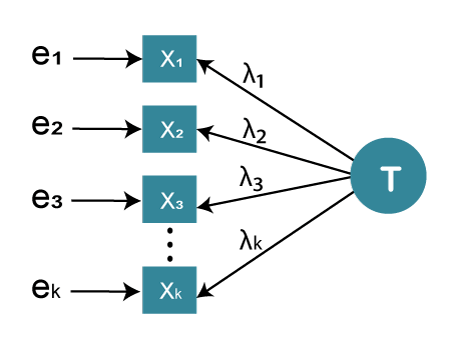Internal Consistency Reliability in SPSS
In this section, we will learn about the third type of reliability coefficient known as internal consistency. Internal consistency reliability is much more popular as compared to the prior two types of reliability: the test-retest and parallel form. It's popular because it tells us about to what extent a test is internally consistent or to what extent there is a good amount of balance or correlation between various parts of the score. Parts of scores mean indicators and dimensions of the score.
- It tells us that if we imagine a human being, then hands, eyes, ears, they all belong to a single person. We are different individuals, so my hands might be different compare to yours and so on. Internal consistency tells us that the eyes, ears, and hands which we obtained in this situation belong to a single person. That is the measure advantage as compared to the prior two types of reliability.
- Test-retest and parallel forms tell us the correlation between two different situations of the score. But they do not tell whether we are addressing the same construct or whether the following kind of measurement model is being created. In fact, in the case of test-retest or parallel form, there is no indication of the measurement model. It's a correlation between two different types of situations. So that's why internal consistency reliability is very popular.

- Internal consistency realizes on a measurement model, and it tells us whether the indicator that we are using is fairly correlated consistent. They measure the same construct, which is our global construct.
- When we say internal consistency reliability asses the specified measurement model, in that case, it measures the extent to which test scores are true score as compared to the error term. So this conceptualization is very simple. If we take a test, our test score, whatever score we have got, is equal to our true score plus the amount of error. It could be like say plus, minus. So, the test score is equal to the true score plus the amount of error.
- If the error is lesser, the test score will be closer to the true score. If there is no error, the test score and true score will be the same. Using the internal consistency reliability, we can determine to what extent our test scores and true scores are closer to each other.
- When it comes to measuring the internal consistency reliability, the most popular coefficient has been the Cronbach's Alpha reliability coefficient. According to the researches, this is the most commonly reported reliability coefficient, especially in psychology and the education I have seen the other discipline's research paper, but most of the scholar reports the Cronbach's alpha. I have rarely seen the test-retest reliability or parallel form reliability. In fact, parallel form reliability is least commonly reported. The most common is Cronbach's alpha, and sometimes we also see the test-retest reliability reported by the scholars.
|
 For Videos Join Our Youtube Channel: Join Now
For Videos Join Our Youtube Channel: Join Now











